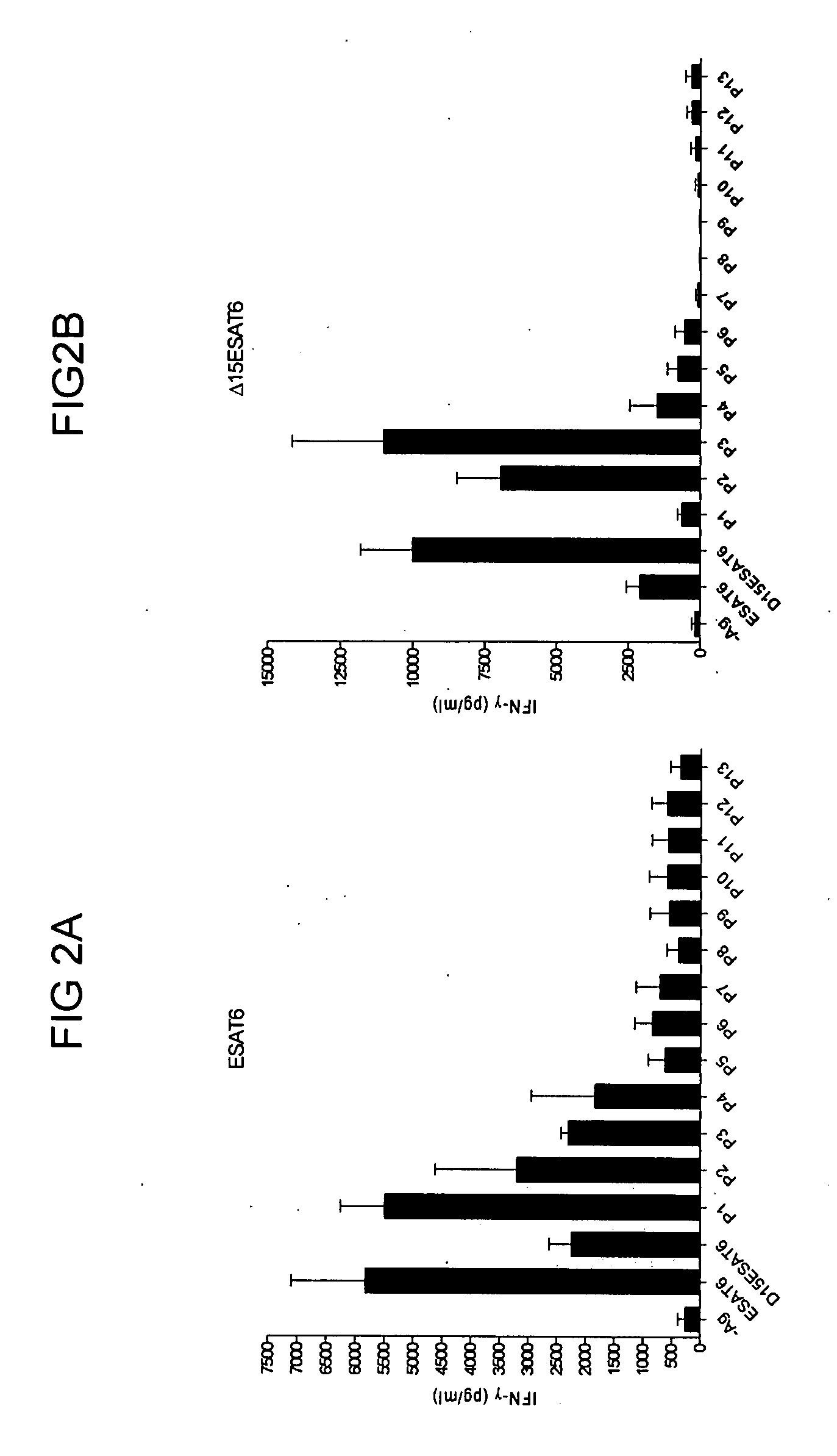Expanding the T cell repertoire to include subdominant epitopes by vaccination with antigens delivered as protein fragments or peptide cocktails
a technology of t cell repertoire and subdominant epitope, which is applied in the field of chronic diseases to prevent the development of efficient vaccines, can solve the problems of chronic or latent disease, large number of escape attempts to develop efficient vaccines, and bacteria not cleared
- Summary
- Abstract
- Description
- Claims
- Application Information
AI Technical Summary
Benefits of technology
Problems solved by technology
Method used
Image
Examples
example 1
ESAT-6
[0086] The degree to which the Mycobacterium tuberculosis—expressed antigen ESAT-6 contains dominant and subdominant epitopes was examined as follows. Mice were vaccinated with the recombinant protein ESAT-6 3 times at 2 weeks interval and cells were taken two weeks after final vaccination from blood and stimulated with the indicated ESAT-6 peptides (FIG. 1A) [SEQ ID NO:1]. After stimulation, secretion of interferon gamma (IFN-γ), as assessed by ELISA, was determined. The results showed an induction of IFN-γ producing T cells specific for P1 (amino acids 1 to 15 of SEQ ID NO: 1) and to a lesser degree P2 (amino acids 7 to 21 of SEQ ID NO: 1). Removing the immunodominant epitope P1 from ESAT6 (giving the construct named “Δ15-ESAT-6 in which the amino acids 1-15 of ESAT 6 (SEQ ID NO:1) have been deleted” (FIG. 1B)) led to immune recognition of new epitopes, P2 and in particular P3 (FIG. 2). This demonstrated that P1 is a dominant epitope, and that P2 and P3 (amino acids 15 to 2...
example 2
TB10.4
[0092] Another protein expressed by M. tuberculosis TB10.4 was analyzed as follows. Mice were vaccinated 3 times at 2 weeks interval with recombinant TB10.4, and cells were taken two weeks after final vaccination from blood and stimulated with 0.5 μg / ml of the indicated TB10.4 peptides (FIG. 4, SEQ ID NO:2) and secretion of IFN-gamma (IFN-γ), as assessed by ELISA, was determined. The results showed that vaccinating with TB10.4 mainly induced P3 specific T cells (FIG. 5). P3 therefore constituted a dominant epitope.
example 3
[0093] To analyze whether the lack of T cells responding to peptides P1 (amino acids 1 to 18 of SEQ ID NO: 2), P2 (amino acids 11 to 28 of SEQ ID NO: 2), P4 (amino acids 31 to 48 of SEQ ID NO: 2), P5 (amino acids 41 to 58 of SEQ ID NO: 2), P6 (amino acids 51 to 68 of SEQ ID NO: 2), and P9 (amino acids 81 to 96 of SEQ ID NO: 2) (and to some degree P7 (amino acids 61 to 78 of SEQ ID NO: 2) and P8 (amino acids 71 to 88 of SEQ ID NO: 2)) was due to these peptide epitopes being subdominant or not immunogenic, animals were vaccinated with the individual TB10.4 peptides (P1-P9). Following vaccination purified lymphocytes were stimulated in vitro the same peptides used for vaccination and secretion of IFN-γ was determined by ELISA. The results showed that other, subdominant (when vaccinating with the recombinant protein TB10.4) peptides were also strongly immunogenic. In particular vaccinating with peptide 1 or 3, or to a lesser degree P7, P8, or P9 induced a specific T-cell response (FIG. ...
PUM
| Property | Measurement | Unit |
|---|---|---|
| concentration | aaaaa | aaaaa |
| diameter | aaaaa | aaaaa |
| size | aaaaa | aaaaa |
Abstract
Description
Claims
Application Information
 Login to View More
Login to View More - R&D
- Intellectual Property
- Life Sciences
- Materials
- Tech Scout
- Unparalleled Data Quality
- Higher Quality Content
- 60% Fewer Hallucinations
Browse by: Latest US Patents, China's latest patents, Technical Efficacy Thesaurus, Application Domain, Technology Topic, Popular Technical Reports.
© 2025 PatSnap. All rights reserved.Legal|Privacy policy|Modern Slavery Act Transparency Statement|Sitemap|About US| Contact US: help@patsnap.com



